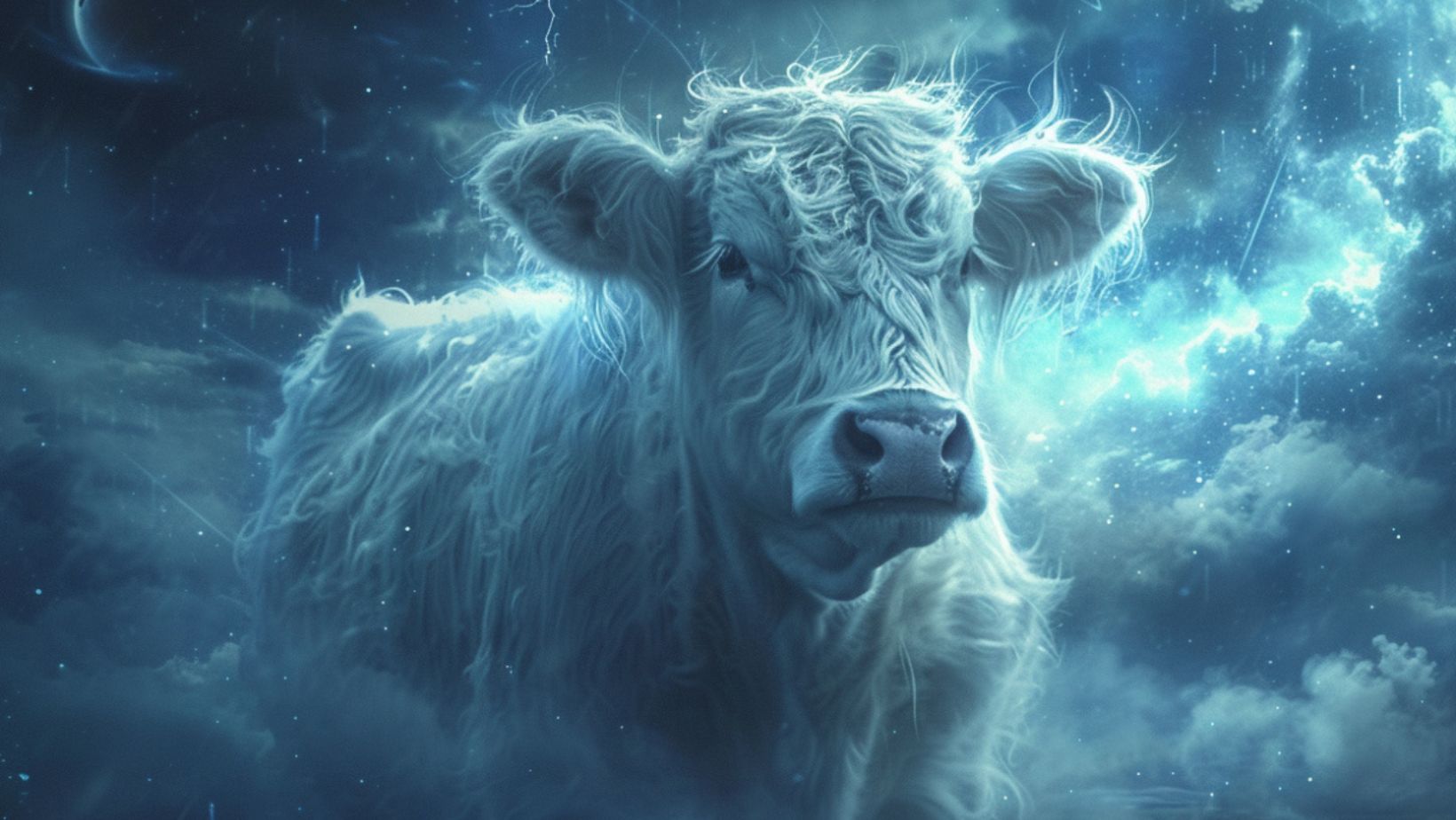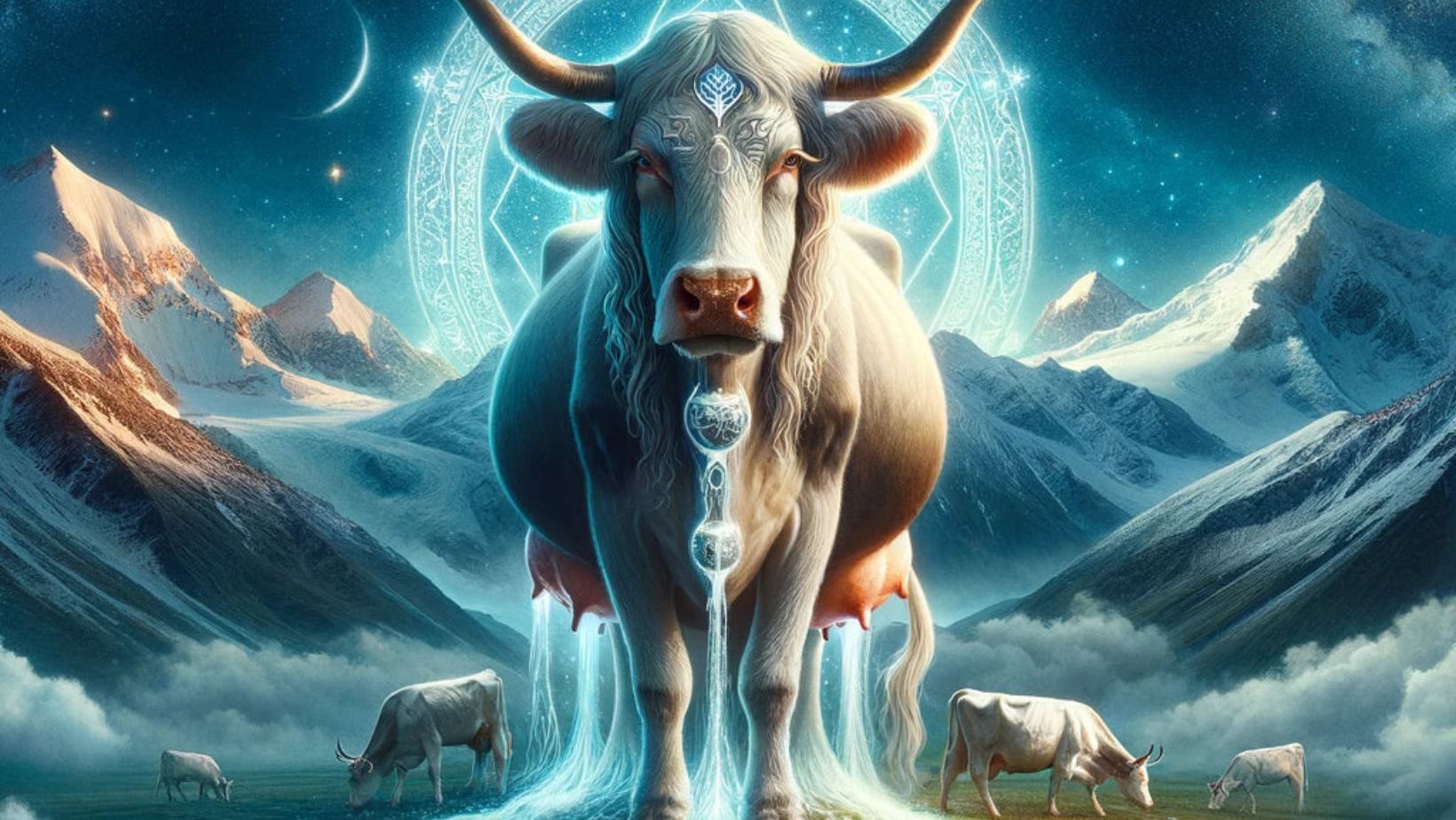In the misty realm of Norse mythology, there’s a creature that’s often overlooked but played a crucial role in the very creation of the world as we know it. I’m talking about Audhumla Norse Myth, the primeval cow. This might sound a bit strange at first – a cow being so important in a mythology filled with powerful gods and giants? But trust me, once you hear her story, you’ll see just how vital Audhumla was in shaping the Norse cosmos.
Audhumla emerged from the primordial void known as Ginnungagap. Her udders flowed with four rivers of milk, which nourished the first giant, Ymir. But that’s not all – as she licked the salty rime stones, she uncovered the first of the Norse gods, Buri. Yep, you read that right. A cow literally licked a god into existence. If that’s not impressive, I don’t know what is!
Table of Contents:
- The Primeval Cow Audhumla in Norse Creation Myth
- The Emergence of Buri from Audhumla’s Licking
- Comparisons and Connections to Other Mythologies
- The Symbolic Meaning of Audhumla in Norse Mythology
- Conclusion
The Primeval Cow Audhumla in Norse Creation Myth: Audhumla Norse Myth
In the vast tapestry of Norse mythology, few figures loom as large as the primeval cow, Audhumla. This mythical beast played a vital role in the Norse creation story, shaping the very foundations of the cosmos.
According to the Prose Edda, written by the Icelandic scholar Snorri Sturluson in the 13th century, Audhumla emerged from the primordial void known as Ginnungagap. She was a creature of immense power and significance, responsible for nourishing the first giant, Ymir, and uncovering the first of the Norse gods.
Audhumla’s Role in Norse Cosmology

In the beginning, there was nothing but the yawning chasm of Ginnungagap. From this void, the primordial cow Audhumla emerged, a being of great importance in the Norse creation myth.
Audhumla’s role was twofold. First, she nourished the giant Ymir with her milk, providing him with the sustenance he needed to grow and thrive. This act of nourishment was crucial, as Ymir would go on to father the race of giants, setting the stage for the conflicts that would shape the Norse cosmos.
The Significance of Audhumla Licking Rime Rocks: Audhumla Norse Myth
But Audhumla’s role didn’t end with nourishing Ymir. As she licked the salty rime rocks that had formed in Ginnungagap, she began to uncover a new being – Buri, the first of the Aesir gods.
This act of licking the rime rocks was highly symbolic. With each passing day, more of Buri was revealed – first his hair, then his head, and finally his entire body. This gradual emergence represented the process of creation itself, as form and life slowly took shape from the primordial elements.
Audhumla and the Creation of Ymir
While Audhumla was busy licking the rime rocks and uncovering Buri, she was also providing sustenance to Ymir, the first giant. Ymir grew strong on Audhumla’s milk, eventually giving rise to the race of giants that would populate the Norse cosmos.
This dual role – nourishing Ymir and uncovering Buri – highlights Audhumla’s importance in the Norse creation story. She was a primordial force, a being capable of bringing forth both the giants and the gods, setting the stage for the conflicts and adventures that would follow.
The Emergence of Buri from Audhumla’s Licking: Audhumla Norse Myth
As Audhumla licked the salty rime rocks, a new figure began to emerge – Buri, the first of the Aesir gods. This process of gradual revelation was a key part of the Norse creation myth, symbolizing the emergence of form and life from the primordial elements.
The First Man Buri Emerges
On the first day of Audhumla’s licking, Buri’s hair appeared from the rime. On the second day, his head was revealed. And on the third day, his entire body emerged, fully formed and ready to take his place in the Norse cosmos.
Buri was a being of great significance, as he represented the first of the Aesir gods, the pantheon that would come to dominate the Norse mythology. His emergence from the rime marked a turning point in the creation story, as the gods began to take shape and assert their influence over the world.
Audhumla’s Nourishment of Buri: Audhumla Norse Myth
Just as Audhumla had nourished Ymir with her milk, allowing him to grow strong and give rise to the giants, she also played a role in sustaining Buri after his emergence from the rime.
Although the details are not explicitly stated in the surviving sources, it is reasonable to assume that Audhumla’s milk also nourished Buri, providing him with the strength and vitality he needed to thrive in the newly-formed world.
The Lineage of Odin from Buri
Buri’s significance in the Norse cosmos extended far beyond his own existence. He was the progenitor of a divine lineage that would eventually lead to Odin, one of the most prominent and powerful gods in Norse mythology.
Buri fathered a son named Borr, who in turn married a giantess named Bestla. From their union came the three sons who would become the most important gods of the Aesir – Odin, Vili, and Vé.
This lineage, stretching from Buri to Odin, underscores the importance of Audhumla’s role in the creation myth. By uncovering Buri from the rime, she set in motion a chain of events that would shape the entire Norse cosmos, giving rise to the gods who would become the central figures of the mythology.
Comparisons and Connections to Other Mythologies: Audhumla Norse Myth
The figure of the primeval cow Audhumla in Norse mythology bears striking similarities to bovine creation figures in other mythological traditions. These parallels suggest a deeper, more universal symbolism associated with the cow as a source of nourishment, life, and creation.
Similarities to Creation Myths in Other Cultures
In Hindu mythology, for example, the cosmic cow Kamadhenu is revered as the mother of all cows and a wish-granting deity. Like Audhumla, Kamadhenu is associated with abundance, nourishment, and the sustaining of life.
Similarly, ancient Egyptian mythology featured the sky goddess Nut, who was sometimes depicted as a cow. Nut’s body was said to arch over the earth, forming the vault of the heavens – a cosmic role not unlike Audhumla’s in the Norse creation story.
Possible Influences on Norse Mythology: Audhumla Norse Myth
Some scholars have suggested that the Norse creation myth, and particularly the role of Audhumla, may have been influenced by other Indo-European mythological traditions.
The motif of a primordial bovine creature, and the act of creation through licking or churning, can be found in various mythologies across the Indo-European spectrum. The cosmic churning of the ocean in Hindu mythology, for example, bears some resemblance to Audhumla’s licking of the rime rocks.
The Significance of Primordial Cows in Mythology
The prevalence of primordial cows in creation myths around the world points to a deeper symbolic significance associated with these creatures. Cows have long been associated with nourishment, fertility, and the sustaining of life – all qualities that are essential to the process of creation.
In the Norse context, Audhumla’s role as a provider of nourishment to Ymir and Buri, and her act of uncovering Buri from the rime, can be seen as a powerful symbolic representation of the life-giving forces that shape the cosmos. Her presence in the creation myth underscores the importance of these primal, nurturing energies in the formation of the world and the gods who would come to inhabit it.
The Symbolic Meaning of Audhumla in Norse Mythology: Audhumla Norse Myth
Audhumla’s role in the Norse creation myth goes beyond the literal narrative of her actions. As a primeval cow, she embodies a range of symbolic meanings that speak to the deeper themes and concepts of Norse cosmology.
Audhumla as a Symbol of Creation and Nourishment

At her core, Audhumla represents the primal forces of creation and nourishment that shape the Norse cosmos. Her milk sustains Ymir, allowing him to grow and give rise to the race of giants, while her licking of the rime rocks uncovers Buri, the first of the Aesir gods.
These acts of nourishment and revelation are deeply symbolic, representing the life-giving energies that flow through the universe, bringing forth form and existence from the primordial void. Audhumla’s role in the creation myth reminds us of the fundamental importance of these nurturing forces in the shaping of the world.
The Duality of Ice and Cow in Norse Cosmology: Audhumla Norse Myth
Audhumla’s presence in the Norse creation myth also highlights the duality that is central to Norse cosmology. The interplay between the primordial ice of Ginnungagap and the warm, nourishing milk of Audhumla represents the balance of opposing forces that shape the cosmos.
The ice symbolizes the cold, lifeless void, while Audhumla’s milk and licking action represent the warmth and vitality that are necessary for creation to occur. This duality is a recurring theme in Norse mythology, as seen in the interplay of fire and ice in the formation of the world.
Audhumla’s Representation of the Life-Giving Force
Ultimately, Audhumla can be seen as a representation of the fundamental life-giving force that underlies all of existence. Her nourishing milk and her act of uncovering Buri from the rime symbolize the essential energies and elements that are necessary for life to emerge and thrive.
In this sense, Audhumla embodies the primal creative power that flows through the Norse cosmos, shaping the world and the beings who inhabit it. Her presence in the creation myth serves as a reminder of the deep, abiding forces that sustain and renew the universe, even in the face of the chaos and destruction that are also part of the Norse mythological cycle.
Through her symbolic role as a source of nourishment, creation, and life-giving energy, Audhumla stands as a powerful and enduring figure in the rich tapestry of Norse mythology. Her story speaks to the fundamental forces that shape our world and the eternal cycle of creation and renewal that lies at the heart of the Norse cosmological vision.
Key Takeaway: Audhumla Norse Myth
Audhumla, the primeval cow in Norse mythology, nourished Ymir and uncovered Buri, shaping both giants and gods. Her actions symbolize creation’s life-giving forces.
Conclusion: Audhumla Norse Myth
Audhumla’s tale in Norse mythology is one that’s both fascinating and a bit quirky. I mean, a cosmic cow licking gods out of salty ice? That’s definitely not something you hear every day. But beyond the surface-level oddities, Audhumla’s story carries some profound symbolism.
Her nourishing milk and life-giving licks represent the forces of creation, the power that brings forth life from the void. In a way, Audhumla embodies the very essence of motherhood and nurturing on a cosmic scale. She’s a reminder that even in the harshest of circumstances, like the icy realm of Ginnungagap, life and growth can still spring forth.
So the next time you hear about Norse mythology, don’t just think of mighty Thor or wise Odin. Remember Audhumla, the primeval cow, and the vital role she played in setting the stage for the Norse cosmos as we know it. Her story may be a bit unconventional, but it’s one that’s truly legendary.

